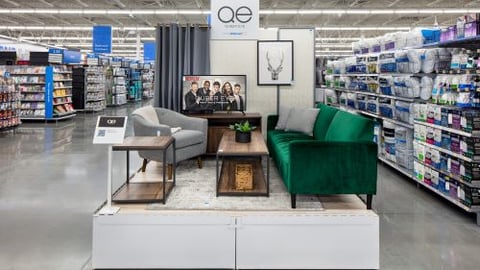Walmart Grabs More Grocery Share in Q4
Americans continue to cram Walmart's physical and digital stores, in a sign that higher prices and inventory challenges are not dampening consumer enthusiasm for shopping.
For the fourth quarter ended Jan. 28, U.S. same-store sales (excluding fuel) at Walmart were up 5.6%. The retailer said comps reflected strong in-store traffic aided by robust consumer spending and a strong holiday. Comp sales were up 14.2% on a two-year stack basis, and January was the strongest month of the quarter. Traffic was up 3.1% during the quarter, and average ticket was up 2.4%.
The retailer said its grocery comps increased by the high single digits, with sales growth and market share gains aided by slightly wider price gaps than pre-pandemic levels and expanded omni offerings; on a two-year stacked basis, sales increased by a mid-teens percentage. Food categories increased in the high-teens percentage on a two-year stack. Consumables reflected strength in pet categories, baby products and beauty, the company said.
“We had another strong quarter to finish off a strong year," said Doug McMillon, CEO of Walmart. "We have momentum in our business in all three segments. We’re being aggressive with our plans and executing on the strategy. It’s exciting to see how the teams are simultaneously navigating today’s challenges and reshaping our business.”
Meanwhile, grocery led sales growth at Sam's Club during the quarter. Sam’s Club comps increased 10.4%, and 21.2% on a two-year stack. Membership income increased 9.1%. Strong comp sales growth driven by a 7% increase in transactions and 3.2% ticket growth, as well as continued stimulus spending and inflation. On a two-year stack, comp sales at Sam's increased 24.8%. The banner's food categories led growth, with freezer/cooler comp growth in the low teens. Fresh meat, produce, floral and prepared foods performed well, the company said. Grocery and beverage comps were positive mid-teens. Drinks, dry grocery and chips showed strength. And consumables comps were positive high single-digits; laundry, home care, pet supplies, and baby care performed well, the retailer said.
“Walmart’s Q4 2021 earning report reflects continued growth but was impacted by supply chain issues, labor shortages and inflation," said Lauren Lang, senior manager at San Francisco-based Constructor. "Walmart’s continued investment in cutting-edge technology and e-commerce capabilities is continuing to pay off and has positioned them to weather these setbacks. Walmart can double down on their e-commerce site as labor shortages continue to impact in-store shopping experiences. But to be successful on the digital side, Walmart must ensure they’re delivering relevant and tailored shopping experiences, especially at a time when customer expectations for e-commerce are at an all-time high. With a comprehensive, thorough search and discovery strategy, Walmart can drive revenue and boost customer loyalty.”
Walmart U.S. e-commerce sales grew 1% and 70% on a two-year stack.
The company said it saw $400 million in higher than expected supply chain costs during the quarter but that it navigated pandemic-related challenges well while executing strategic initiatives. It said inventory was up 26% globally; 28% in the United States, affected by higher cost of goods, mix and higher in-transit shipments.
Walmart reported net income of $3.56 billion, or $1.28 per share, compared with a loss of $2.09 billion, or 74 cents per share, a year earlier. Total revenue rose slightly to $152.87 billion from $152.08 billion a year earlier.
During the quarter, Walmart remodeled more than 140 stores; it plans to remodel 600 stores in fiscal 2022. The retailer now has grocery pickup in 4,600 locations and same-day delivery from 3,500 stores. The company said the number of customers utilizing Walmart's delivery services has increased six-fold compared to pre-pandemic.
For the full year, total revenue was $572.8 billion, up 2.4%, negatively affected by $32.7 billion related to divestitures. Excluding currency, total revenue would have increased 1.6% to $568.2 billion. The retailer's global advertising business reached $2.1 billion as the company’s flywheel accelerates. In the United States, active advertisers using Walmart Connect increased 136%.
Sam’s Club comp sales for the year increased 9.8% and 21.6% on a two-year stack. Membership income increased 11.3%. Walmart International net sales decreased 16.8%, negatively affected by approximately $32.6 billion related to divestitures.
In January, Walmart and Quest Diagnostics announced they will offer consumer-initiated laboratory testing powered by QuestDirect. The new solution enables people to take control of their health care and purchase through a consumer-friendly website the same high-quality lab tests ordered by health care providers. This offering builds upon a long-standing relationship between Walmart and Quest to increase access to high-quality health services.
Bentonville, Ark.-based Walmart operates approximately 10,500 stores under 48 banners in 24 countries, and e-commerce websites, employing 2.2 million-plus associates worldwide. Walmart U.S. is No. 1 on The PG 100, Progressive Grocer’s 2021 list of the top food and consumables retailers in North America.




